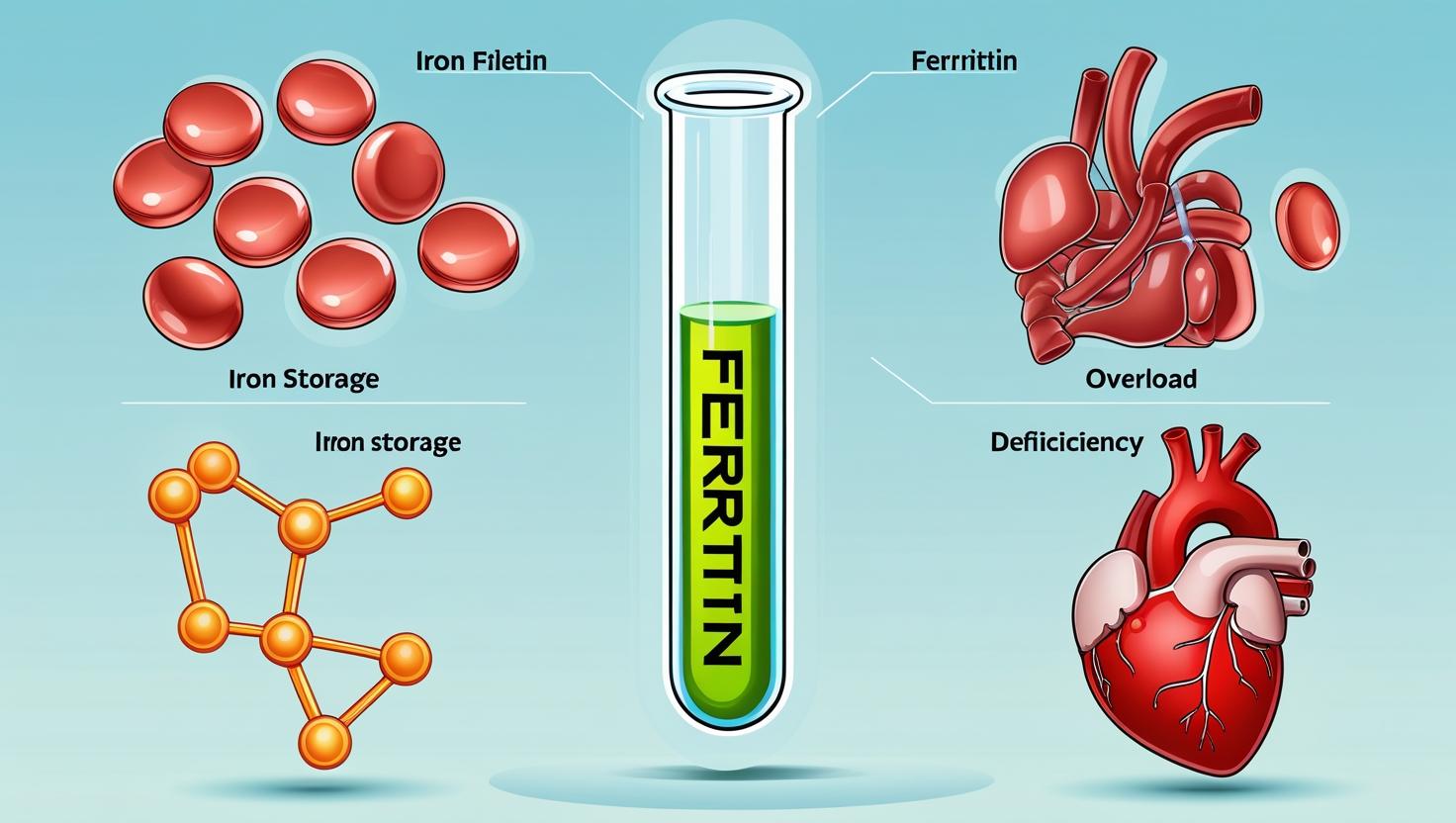When it comes to your health, iron plays a vital role in keeping your body functioning properly. Without enough iron, you may feel constantly tired, weak, or short of breath. But too much iron can also be harmful, leading to serious conditions such as liver disease or heart problems. That’s why checking ferritin levels is an important step in understanding your body’s iron balance.
Ferritin is not just another blood test—it is a key marker that tells doctors how much iron your body has stored. In this guide, we’ll break down everything you need to know about ferritin, including what it is, why the test is done, normal ranges, high and low results, symptoms, causes, treatment options, and how you can maintain healthy levels.

What is Ferritin?
Ferritin is a protein that stores iron in your cells and releases it when your body needs it. Think of it as your iron storage bank. Instead of floating around in your bloodstream, most of your iron is stored inside ferritin molecules.
When you take a ferritin blood test, it measures the amount of ferritin in your blood, which reflects your overall iron stores. This helps doctors figure out whether you have iron deficiency, iron overload, or another related condition.
Why is the Ferritin Test Important?
Iron is essential for producing hemoglobin, the protein in red blood cells that carries oxygen throughout the body. Without enough iron, your body can’t make healthy red blood cells, leading to anemia. On the other hand, too much iron can damage vital organs.
Doctors order a ferritin test for many reasons, such as:
- Checking for iron deficiency anemia.
- Investigating unexplained fatigue or weakness.
- Monitoring conditions like hemochromatosis (iron overload).
- Evaluating chronic diseases that affect iron levels.
- Assessing response to iron supplements or treatments.
Normal Ferritin Levels
Normal ferritin levels vary depending on age, sex, and laboratory standards. Typically:
- Men: 24–336 ng/mL
- Women: 11–307 ng/mL
- Children (1–18 years): 7–140 ng/mL
- Infants (up to 1 year): 25–200 ng/mL
(Note: Values may slightly differ depending on the lab.)
Having ferritin levels outside the normal range does not always mean a disease is present, but it does signal that your iron balance may need attention.
Low Ferritin Levels: Causes & Symptoms
Causes of Low Ferritin
Low ferritin usually means low iron stores, often due to:
- Iron deficiency anemia (most common).
- Blood loss (heavy periods, ulcers, or gastrointestinal bleeding).
- Poor diet lacking in iron-rich foods.
- Pregnancy, when iron demand increases.
- Chronic diseases like celiac disease or inflammatory bowel disease that affect absorption.
Symptoms of Low Ferritin
When ferritin is low, your body lacks the iron needed to make enough hemoglobin. Common symptoms include:
- Constant fatigue and weakness.
- Pale skin and brittle nails.
- Shortness of breath during simple activities.
- Headaches and dizziness.
- Unusual cravings for non-food items (pica), such as ice, clay, or dirt.
- Cold hands and feet.
If untreated, low ferritin can progress to severe anemia, affecting heart and brain function.
High Ferritin Levels: Causes & Symptoms
Causes of High Ferritin
High ferritin usually means excess iron, but it can also rise due to inflammation or liver problems. Causes include:
- Hemochromatosis (a genetic condition causing iron overload).
- Chronic liver disease (hepatitis, cirrhosis, fatty liver).
- Frequent blood transfusions.
- Chronic inflammatory diseases (rheumatoid arthritis, lupus).
- Certain cancers (leukemia, Hodgkin’s lymphoma).
- Alcohol abuse.
Symptoms of High Ferritin
Symptoms may not appear until iron overload causes organ damage. They include:
- Joint pain and arthritis-like symptoms.
- Abdominal pain.
- Unexplained fatigue.
- Darkening of skin (bronze or grayish tone).
- Irregular heartbeat or heart failure.
- Diabetes (from iron buildup in the pancreas).
High ferritin is often detected during routine blood tests before symptoms appear.
Ferritin Test Procedure
The ferritin test is a simple blood test. Here’s what to expect:
- A healthcare provider draws blood from a vein in your arm.
- The sample is sent to a lab for analysis.
- Results are usually available within 24–48 hours.
You may need to fast (avoid eating or drinking for 8–12 hours) if ferritin is ordered with other tests like an iron panel or lipid profile.
Factors That Affect Ferritin Levels
Several factors can influence ferritin levels beyond iron intake:
- Infections and inflammation can raise ferritin even without excess iron.
- Menstruation and pregnancy can lower ferritin levels.
- Alcohol consumption can increase ferritin.
- Medical treatments (like chemotherapy or dialysis) may alter results.
That’s why doctors often interpret ferritin results along with other tests, such as:
- Serum iron
- Total iron-binding capacity (TIBC)
- Transferrin saturation
- Hemoglobin and hematocrit
Treatment for Low Ferritin
If your ferritin is low, treatment focuses on restoring healthy iron levels:
- Dietary changes – Eat more iron-rich foods:
- Red meat, chicken, fish.
- Leafy green vegetables.
- Beans and lentils.
- Iron-fortified cereals.
- Iron supplements – Prescribed tablets or liquid iron.
- Vitamin C intake – Helps improve iron absorption.
- Treating the cause – Address bleeding, malabsorption, or chronic conditions.
Treatment for High Ferritin
If ferritin is high, the goal is to reduce iron overload or treat the underlying condition:
- Therapeutic phlebotomy – Regular blood removal to lower iron.
- Chelation therapy – Medication that binds iron and helps remove it from the body.
- Lifestyle changes – Avoid alcohol, iron supplements, and vitamin C supplements.
- Treat underlying diseases – Managing liver problems, infections, or inflammatory conditions.
How to Maintain Healthy Ferritin Levels
- Eat a balanced diet with the right amount of iron.
- Avoid excess supplementation unless prescribed.
- Limit alcohol to protect your liver.
- Regular check-ups if you have conditions like hemochromatosis or chronic anemia.
- Exercise regularly to support overall health.
When Should You See a Doctor?
You should talk to your doctor about a ferritin test if you experience:
- Persistent fatigue or weakness.
- Unexplained joint pain or abdominal pain.
- Irregular heartbeat or shortness of breath.
- Unusual skin changes (bronze or pale).
- Heavy menstrual bleeding or unexplained blood loss.
Early detection and treatment of abnormal ferritin levels can prevent serious complications.
Key Takeaways
- Ferritin is a protein that stores iron in your body.
- Low ferritin usually indicates iron deficiency, while high ferritin can signal iron overload or inflammation.
- A ferritin blood test is simple and effective for checking your iron stores.
- Maintaining balanced ferritin levels is crucial for energy, immunity, and organ health.
- Always consult your doctor before starting or changing supplements or treatments.
Conclusion
Ferritin may be a small protein, but it plays a big role in your overall health. Understanding your ferritin levels can help uncover hidden issues such as iron deficiency or overload, which can impact your energy, heart, liver, and more. With the right diet, lifestyle habits, and medical guidance, you can maintain healthy ferritin levels and support your body’s essential functions.
